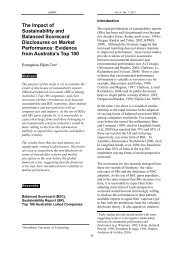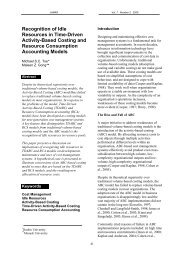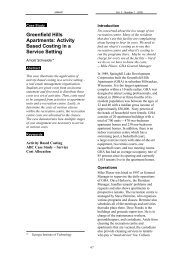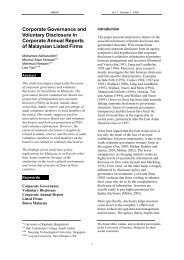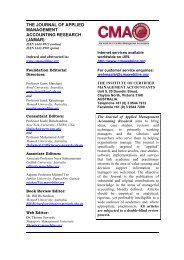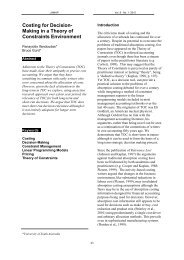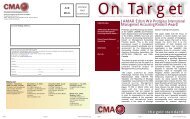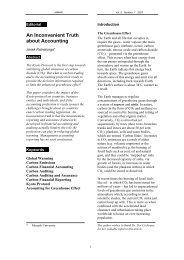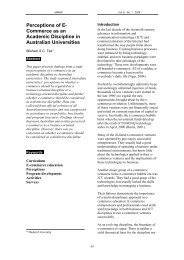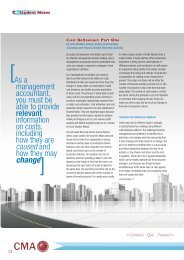Investigating the Determinants of Perceived Procedural Fairness in ...
Investigating the Determinants of Perceived Procedural Fairness in ...
Investigating the Determinants of Perceived Procedural Fairness in ...
- No tags were found...
Create successful ePaper yourself
Turn your PDF publications into a flip-book with our unique Google optimized e-Paper software.
JAMAR Vol. 11 · No. 1 2013goals to be achieved by managers.Additionally, <strong>the</strong> study f<strong>in</strong>ds that <strong>the</strong> type <strong>of</strong>performance measures (whe<strong>the</strong>r f<strong>in</strong>ancial ornonf<strong>in</strong>ancial) used to evaluate managers is notassociated with perceived procedural fairness.It would seem that much <strong>of</strong> <strong>the</strong> prioraccount<strong>in</strong>g literature has overemphasised <strong>the</strong>importance that performance measure typesmay have on procedural fairness, whe<strong>the</strong>rbudget constra<strong>in</strong>ed, pr<strong>of</strong>it conscious or nonaccount<strong>in</strong>g,to <strong>the</strong> neglect <strong>of</strong> more criticalvariables.This study contributes to <strong>the</strong> literature <strong>of</strong>procedural fairness <strong>in</strong> <strong>the</strong> context <strong>of</strong> PMERSby provid<strong>in</strong>g empirical evidence on factorswhich <strong>in</strong>fluenced perceived proceduralfairness. Look<strong>in</strong>g at <strong>the</strong> practical implications<strong>of</strong> <strong>the</strong> study, <strong>the</strong> results suggest that superiorsshould focus on goal-related variables, i.e.participation <strong>in</strong> sett<strong>in</strong>g performance targets,<strong>the</strong> goal-atta<strong>in</strong>ment-reward l<strong>in</strong>k, and <strong>the</strong>specificity <strong>of</strong> goals to be achieved bysubord<strong>in</strong>ates <strong>in</strong> design<strong>in</strong>g PMERS ra<strong>the</strong>r thanon <strong>the</strong> types <strong>of</strong> performance measures.The study, however, should be <strong>in</strong>terpretedcautiously for <strong>the</strong> follow<strong>in</strong>g reasons. The firstone is <strong>the</strong> <strong>in</strong>herent limitations associated withsurvey method. Future study should exam<strong>in</strong>e<strong>the</strong> issue us<strong>in</strong>g o<strong>the</strong>r approaches, such asexperimental design. Secondly, this studydraws on managers from just threeorganisations. Future study could exam<strong>in</strong>e <strong>the</strong>model us<strong>in</strong>g samples derived from moreorganisations. Thirdly, some variables weremeasured us<strong>in</strong>g a s<strong>in</strong>gle item. However, tocompensate this we have conducted<strong>in</strong>terviews. Future study could use <strong>the</strong> bettermeasure to study <strong>the</strong> same topic..Notwithstand<strong>in</strong>g <strong>the</strong>se limitations, we believethat this study provides clarity on factorsaffect<strong>in</strong>g perceived procedural fairness.ReferencesAnthony, R. and Gov<strong>in</strong>darajan, V. (1998),Management Control Systems, Irw<strong>in</strong>, Chicago.Bies, R. J. and Shapiro, D. L. (1998), “Voiceand justification: Their <strong>in</strong>fluence onprocedural fairness judgments”, Academy <strong>of</strong>Management Journal, September, 3: pp. 676-685.Cohen, J. and Cohen, P. (1983), AppliedMultiple Regression: Correlation Analysis for<strong>the</strong> Behavioral Sciences, L. ErlbaumAssociates, New Jersey, USA.Earley, P. C. and Kanfer, R. (1985), “The<strong>in</strong>fluence <strong>of</strong> component participation and rolemodels on goal acceptance, goal satisfaction,and performance”, Organizational Behaviorand Human Decision Processes, 36 (3): pp.378-390.Ehlen, C. R. and Welker, R. B. (1996),“<strong>Procedural</strong> fairness <strong>in</strong> <strong>the</strong> peer and qualityreview programs”, Audit<strong>in</strong>g: A Journal <strong>of</strong>Practice & Theory, 15 (1): pp. 38-52.Emmanuel, C. R., Otley, D. T., Merchant, K.A. (1990), Account<strong>in</strong>g for ManagementControl, Chapman and Hall, London, UK.Fang, E., Evans, K. R., Zou, S. (2005), “Themoderat<strong>in</strong>g effect <strong>of</strong> goal-sett<strong>in</strong>gcharacteristics on <strong>the</strong> sales control systems-jobperformance relationship”, Journal <strong>of</strong> Bus<strong>in</strong>essResearch, 58 (9): pp. 1214-1222.Folger, R. (1977), “Distributive andprocedural justice: comb<strong>in</strong>ed impact <strong>of</strong>"voice" and improvement on experienced<strong>in</strong>equity”, Journal <strong>of</strong> Personality and SocialPsychology, 35 (2): pp. 108 - 119.Folger, R. and Konovsky, M. A. (1989),“Effects <strong>of</strong> procedural and distributive justiceon reactions to pay raise decisions”, Academy<strong>of</strong> Management Journal, 32 (1): pp. 115-130.Greenberg, J. (1986), “<strong>Determ<strong>in</strong>ants</strong> <strong>of</strong>perceived fairness <strong>of</strong> performanceevaluations”, Journal <strong>of</strong> Applied Psychology,71 (2): pp. 340-342.Greenberg, J. and Folger, R. (1983),“<strong>Procedural</strong> justice, participation and <strong>the</strong> fairprocess effect <strong>in</strong> groups and organizations”,In: PAULUS, P. (Ed.) Basic Group Process,Spr<strong>in</strong>ger-Verlag, New York, USA.Hair, J. R., Anderson, R. L., Tatham, R.E.W.C. B. (1998), Multivariate Data Analysis:With Read<strong>in</strong>gs, Pearson, New Jersey, USA.Hall, M. (2008), “The effect <strong>of</strong> comprehensiveperformance measurement systems on roleclarity, psychological empowerment andmanagerial performance”, Account<strong>in</strong>g,40




